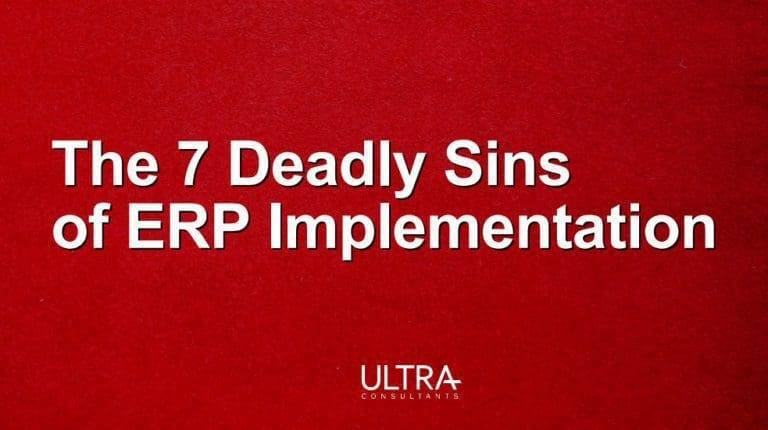The Sixth Deadly Sin of ERP Implementation

#6: Failure to Get Organizational Buy In
Today’s business landscape is ever changing. Therefore, for any successful implementation of any change initiative, organizational buy-in is crucial for success. Without the support and commitment of employees at all levels, even the most well-planned and strategic changes can face resistance and ultimately fail.
In this article, we will explore the importance of organizational buy in and provide practical strategies to achieve it.
The 7 Deadly Sins of ERP Implementation
Before diving into the strategies to achieve employee buy-in, it is important to mention the 7 Deadly Sins of ERP Implementation. These are common pitfalls that organizations should avoid in order to maximize the chances of success. They include:
- Poor project planning
- Less-than-thorough requirements gathering
- Excluding critical users from the process
- Not prioritizing the user experience
- Failing to consider an industry-specific solution
- Providing inadequate internal support
- Neglecting change management
The sixth sin, which is the focus of this article, is providing inadequate internal support. By addressing this sin and ensuring organizational buy-in, your company can overcome the challenges associated with change and achieve their desired outcomes.
The Significance of Employee Buy-In
Employee buy-in refers to the understanding, acceptance and active engagement of employees in a decision or change that is necessary for the success of your organization. It goes beyond mere compliance and requires employees to genuinely believe in and support the change.
When employees have fully bought into the change, they are more likely to be motivated, engaged and willing to contribute their best efforts towards achieving your company’s goals. This, in turn, leads to higher job satisfaction, improved company outcomes and increased innovation through a greater sense of belonging and ownership.
On the other hand, without buy-in, ERP implementation becomes an uphill battle. Employees may resist or undermine the process, leading to delays, inefficiencies and even project abandonment.
The Challenges of Obtaining Employee Buy-In
Obtaining employee buy-in is easier said than done. Employees may have concerns about job security, changes to their roles and responsibilities, or the disruption of established routines. Middle managers in particular play a crucial role in shaping employee attitudes toward change, as they provide a valuable link between senior leadership and front-line employees. If middle managers are not on board, their influence can hinder the implementation process.
Furthermore, employees may be skeptical about the benefits of the ERP system, especially if they have experienced failed implementations in the past. Their past experiences may lead to a “status quo” mentality, where they resist any change that disrupts their comfort zone. Overcoming this skepticism and building trust is essential to obtaining buy-in.
The Effects of Inadequate Internal Support
Inadequate internal support, or the failure to obtain organizational buy-in, can have detrimental effects on the success of change initiatives. Research has shown that the majority of companies that fail to achieve their desired transformation goals lack the necessary internal support and employee engagement.
Without buy-in, employees may resist change, become cynical or indifferent and ultimately hinder the progress of the initiative. This resistance may lead to delays, increased costs and even the complete failure of the change effort.
Strategies to Achieve Employee Buy-In
Communicate the Vision and Purpose The first step in achieving organizational buy-in is to clearly communicate the vision and purpose of the change initiative.
Employees need to understand why the change is necessary, how it aligns with your company goals and how it will benefit them personally. This can be done through town hall meetings, departmental meetings and individual conversations.
Providing concrete examples and success stories can help employees visualize the positive impact of the change. Thus, having a clear vision that is communicated with your employees is critical.
Involve Employees in the Decision-Making Process
When employees are actively involved in the decision-making process, they are more likely to feel a sense of ownership and buy-in for the change. This can be achieved through co-creation sessions, focus groups or surveys.
By soliciting others’ opinions, ideas and concerns, leaders demonstrate that their input is valued and that their voices matter. This involvement also helps to identify potential roadblocks and gain valuable insights into the practicalities of implementing the change.
Engage Middle Managers as Key Influencers
While leadership teams play a crucial role in driving change, middle managers often have significant influence over their teams. They can make or break the success of the change initiative.
Engaging middle managers as key influencers is essential for obtaining employee buy-in. These informal leaders can use their influence, intelligence and networking abilities to shape the perception and acceptance of the change. By involving them early in the change process and addressing their concerns, leaders can build confidence and establish a solid foundation for change.
Provide Clear Roles and Responsibilities
To ensure employee buy-in, leadership needs to help employees understand their roles and responsibilities in the change process of the business.
To promote buy in, clear communication of expectations and accountability is essential. This can be achieved through job descriptions, role clarifications and regular check-ins. When you explain to employees what is expected of them and how their work contributes to the new direction of the change effort, they are more likely to feel a sense of purpose and ownership.
Foster a Culture of Continuous Learning and Improvement
One of the biggest challenges is to create a culture of continuous learning and improvement, which is crucial for the long-term success and sustainability of change initiatives.
Team members need to feel supported and empowered to acquire new skills, adapt to new processes and embrace change. This can be achieved through training programs, workshops and mentorship opportunities.
By investing in employee development and providing resources for growth, leaders demonstrate their commitment to the team members’ success and foster a culture of continuous improvement, in turn creating buy-in.
Recognize and Reward Progress
Recognizing and rewarding progress is a powerful way to create buy-in and motivate employees to continue their efforts towards achieving your company goals of change.
Publicly acknowledging and celebrating milestones, achievements, good ideas and contributions boosts morale, enhances job satisfaction, enhances employee retention and creates a positive feedback loop. This can be done through team celebrations, individual recognition and performance-based incentives.
As you determine to link rewards to the successful implementation of the change, your business will further reinforce the importance of buy-in and create a culture of accountability.
Address Resistance and Provide Support
Resistance to change is natural, and business leaders must be prepared to address it head-on. It is critical to create a safe space for employees to express their ideas and concerns, ask questions and provide feedback.
Good business leadership practice is to actively listen, empathize and address these concerns in a transparent and timely manner. Providing support through coaching, training and resources can help employees navigate the challenges of organizational change. This makes them build their confidence and genuine interest in the project.
By addressing resistance and providing support, your organization fosters a sense of trust, mitigates potential roadblocks and increases buy-in.
Conclusion
Achieving organizational buy in is crucial for the successful implementation of change initiatives. By following these strategies, leaders can create a culture of collaboration, engagement and ownership.
Clear communication, involvement in decision-making, engagement of middle managers, clear roles and responsibilities, fostering a culture of continuous learning and improvement, recognizing and rewarding progress and addressing resistance are all key elements in obtaining organizational buy in. When your employees and other key stakeholders are on the same page, you can navigate your organizational change more effectively, achieve its desired outcomes, and thrive in today’s dynamic business environment.
Ultra Consultants is an independent ERP implementation partner. With our experience, we can help you avoid this deadly sin of ERP implementation and ensure that you avoid a failed ERP implementation project due to inadequate internal support and stakeholder buy-in. Contact us for more information and additional resources.

The 7 Deadly Sins of ERP Implementation
Some mistakes are just bad strategic or financial decisions. Some are the inevitable consequence of situational or organizational factors. Some, however, are the result of process-oriented or people-centric choices – and are easily avoided. These are The Seven Deadly Sins of ERP Implementation.
Table of Contents
More ERP material...
Selecting the Right TMS System: Key TMS Features and Trends to Consider
Data analytics holds the ability to highlight inefficient manufacturing processes and enable…
Choosing a CRM System for Your Business
Data analytics holds the ability to highlight inefficient manufacturing processes and enable…
The Undeniable Benefits of Implementing ERP in Food and Beverage Manufacturing
Data analytics holds the ability to highlight inefficient manufacturing processes and enable…



